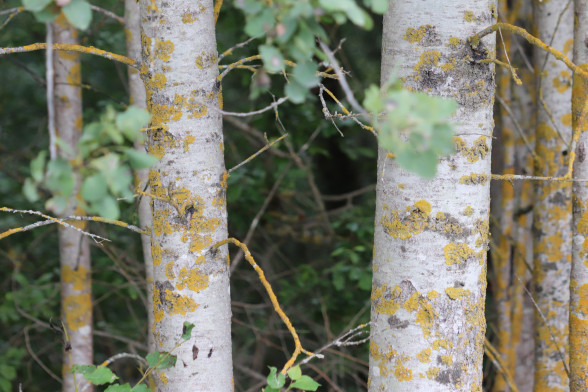
Quaking Aspen /Populus tremula/
Quaking aspen is a deciduous tree of the willow family, commonly found in Latvia's deciduous and mixed forests. Aspen trees can reach heights of up to 40 m and have a trunk diameter of 1 meter. Their lifespan is typically 100-150 years, rarely more. The bark is initially smooth and greenish-gray, later becoming darker and fissured after around 50 years. The wood is light in color.
Aspen trees have a strong root system that extends up to 20-40 m beyond the canopy. The upper side of the leaves is green, while the underside is lighter, turning predominantly red in the autumn. The leaf stems are long and flattened at the ends, causing the leaves to quiver even with slight air or branch movements.
Aspens are heliophilic, meaning they thrive in sunlight, are not demanding in terms of warmth, and are resistant to frost. They prefer soils rich in organic matter but do not tolerate stagnant water well. In forests, aspens often coexist with birches.
The economic significance of aspen is notable. The wood is light, soft, and burns with minimal smoke, making it suitable for making matches, pulp, wood chips, veneer, cellulose, charcoal, and more. In open conditions, aspen wood develops a characteristic bluish tint after 2-3 years. However, its usage is limited due to its softness and susceptibility to deformation, making it less desirable for furniture or flooring production.
Aspens are prone to wood diseases. Due to their palatability to various forest animals, young shoots often need protection with plastic covers. The bark is used for tanning leather and obtaining yellow and green dyes.
Interesting and important facts
The heightened response of aspen leaves to the wind has given rise to various legends. In pagan mythology, the belief persists that the quivering of aspen leaves neutralizes vampires and other malevolent beings who might otherwise return after death. It is also thought to ward off black magic and generally repel evil spirits. These echoes find resonance in Christian traditions, which suggest wearing a small cross made from aspen wood as protection against malevolent creatures, although the church disputes this as superstition.
In Christian mythology, the trembling of aspen leaves is associated with the scourging of Christ on the cross. Interestingly, some sources claim that the cross of Christ was made from aspen wood, despite aspens not growing in Palestine, where these events transpired. In certain Christian traditions, it is asserted that Judas Iscariot hanged himself on an aspen tree.
These legends and beliefs imbue the quivering aspen leaves with symbolic significance, portraying them as a protective force against evil in both pagan and Christian cultures.
Information sources: https://www.latvijasdaba.lv, Wikipedia
Photo: pixabay.com

